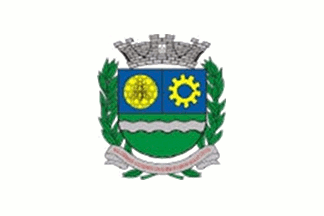 image by Dirk Schönberger,
26 November 2012
image by Dirk Schönberger,
26 November 2012Source: http://www.jandira.sp.gov.br/index.php?option=com_content&view=article&id=53&Itemid=92

Last modified: 2012-12-29 by ian macdonald
Keywords: sao paulo | jandira | bee |
Links: FOTW homepage |
search |
disclaimer and copyright |
write us |
mirrors
 image by Dirk Schönberger,
26 November 2012
image by Dirk Schönberger,
26 November 2012
Source:
http://www.jandira.sp.gov.br/index.php?option=com_content&view=article&id=53&Itemid=92
A white flag with the municipal arms in the centre.
Official website at
http://www.jandira.sp.gov.br/
Dirk Schönberger,
26 November 2012
Jandira, like the neighbouring municipalities, emerged thanks to the Sorocabana Railways. On 11 April 1912, Antonio Agú - the founder of Osasco - and Henrique Sammartino - the founder of Jandira, purchased a piece of land from Nicola Beneducci and Miguel Samarone, which they named Sítio das Palmeiras (Palm Grooves' Site). In 1925, the railways company inaugurated a coal resupplying post called "Km 32". On 20 March 1931, the telegraph post was inaugurated, which consisted in the earliest emergence of Jandira, then part of Cotia. In the 1950s, Jandira was made a district of Cotia. União Pró-Jandira, founded on 25 January 1951, struggled for the emancipation of Jandira. An attempt of incorporation of Jandira to Barueri, through Law No. 170 of 28 April 1958, failed. In a plebiscite organized on 8 December 1963, the inhabitants approved the emancipation. The municipality of Jandira was established on 28 February 1964 and inaugurated on 7 March 1965. The first Mayor was Oswaldo Sammartino, son of the founder Henrique Sammartino.
The flag, coat of arms and anthem are listed as the municipal symbols, without further description, in Article 4 of the Municipal Constitution, last amended on 21 March 2006.
http://www.jandira.sp.gov.br/downloads/lei-organica-jandira.pdf - Municipal Constitution
The flag, prescribed by Law No. 1,346 (adoption date not given), is white with the municipal coat of arms in the middle.
The coat of arms, prescribed by Laws No. 4 and 5 of 21 April 1967, is "Per fess, 1. Azure dexter a honeybee on a honeycomb sinister a cogwheel all or, 2. Vert in chief a fess wavy argent. The shield surmounted by mural crown argent charged with an escutcheon 'Argent a fleur-de-lis argent fimbriated sable'. The shield supported by branches of oak (dexter) and laurel (sinister) vert. Below the shield a scroll argent inscribed with the motto ''NISI DOMINUS CUSTODIERIT CIVITATEM, IN VANUM VIGILAT CUSTOS' in letters gules."
The honeybee makes the arms canting, recalling that "jundeira" means in Tupi-Guarani "a honeybee". It also represents the intrepidity, the big conquests and the commitment to constructive work of the inhabitants of the town. The cogwheel symbolizes industry, especially refrigeration industry (Jandira S.A.). The green field represents the fertile soil of Jandira and the local significance of agro-industry. The fess wavy represents river Barueri-Mirim, a tributary of river Tietê, once used by the pioneers in their expeditions. The mural crown is the symbol of a municipality. The escutcheon (described as azure but represented as white) with the fleur-de-lis recalls the Blessed Virgin, the patron saint of the town. The branch of oak represents constant work and study. It recalls José Manoel da Conceição*, who used to take some rest in the shadow of a big fig tree. The branch of laurel represents glory and just reward for civic work. The Latin motto, meaning "Unless the Lord guards the community, he keeps watch in vain who guards it", comes from Psalm 127.
* José Manoel da Conceição (1822-1873) was a missionary of the Presbyterian Church of Brazil. A former Roman Catholic Priest, he was the first Brazilian to be ordained a Protestant minister (1865).
Photo of the flag:
http://www.paginazero.dominiotemporario.com/site/politica/2516-emendas-pela-cidade-rendem-a-arlindo-chinaglia-titulo-de-cidadao-jandirense.html
- 2 July 2010
This photo casts some doubt on the charge in chief dexter, which seems here to
include a white disk.
Ivan Sache, 1 December 2012